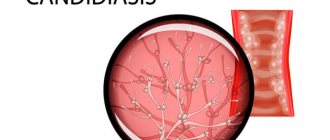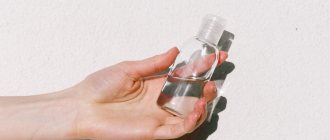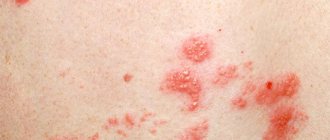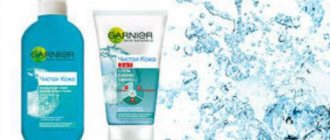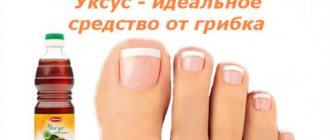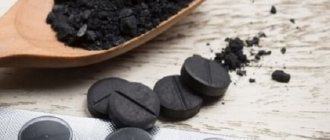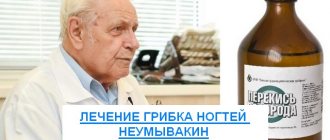Clear skin / Acne products / Other products / How to use Chlorophyllipt for acne?
Acne on the face is a fairly common problem.
And, despite the fact that in our century many drugs have been developed to treat them, finding a suitable remedy is not so easy .
In this article we will take a closer look at an effective remedy for acne on the face - Chlorophyllipt .
About the drug
Chlorophyllipt is a drug of natural origin that has an antimicrobial and anti-inflammatory effect.
It contains chlorophylls from eucalyptus leaves, which is why the drug is classified as an antiseptic drug .
The drug contains many useful components included in eucalyptus raw materials. It provides the necessary dose of minerals: calcium, manganese, iron, aluminum, magnesium, barium, cobalt - and this is not the whole list.
In addition, eucalyptus raw materials contain essential oil, phytoncides and tannins.
The product is produced in the form of a spray, tablets, oil or alcohol solution .
Chlorophyllipt
Chlorophyllipt is an antimicrobial drug of plant origin, obtained from the extract of leaves of Eucalyptus rodum and Eucalyptus globulus. It has bactericidal, antiviral, antifungal, antiprotozoal (destructive to protozoa) and anti-inflammatory effects. The strength of the drug is largely determined by the content of essential oils in it. Herbal medicines used to treat skin diseases, as a rule, contain plant extracts, including a whole scattering of biologically active substances. The natural origin of such drugs makes them non-toxic (with rare exceptions), lack of irritating effect, and hypoallergenic. Of particular interest (and not only for herbalists) are plant extracts that are active against “problematic” bacterial strains that exhibit resistance to certain antibiotics and synthetic antibacterial agents. One such drug is chlorophyllipt. The scope of its application is quite wide: it includes dermatology, dentistry, gynecology, surgery, and ENT therapy. There is successful experience in the use of chlorophyllipt in the treatment of trophic ulcers and burns, dermatitis and phlegmon, burns and bedsores, as well as a number of allergic and purulent-inflammatory skin diseases. As previous studies have shown, the main active ingredients of the drug that exhibit antibacterial activity against antibiotic-resistant forms of staphylococci are euglobals (phenolaldehydes) - terpene derivatives that have a destructive effect on bacteria. When taken orally and inhaled, chlorophyllipt (as well as all eucalyptus preparations) thins and improves mucus discharge, promotes better expectoration, and when applied to the skin, it has an antiexudative, antipruritic, astringent, analgesic effect; in higher doses the drug additionally exhibits a local irritating effect. Chlorophyllipt is valuable, first of all, for its antistaphylococcal activity, manifested due to the presence in the preparation of a mixture of green pigments from eucalyptus leaves.
The components of chlorophyllipt - essential oils, tannins, organic acids, microelements - increase the resistance of organs and tissues to hypoxia of various etiologies.
Chlorophyllipt is available in three dosage forms: an alcohol solution for oral administration and topical use, an oily solution for topical use, and lozenges. The dose, frequency of administration and duration of the medication course are determined individually, taking into account medical indications and the dosage form intended for use. I would like to finish the article with a small “ode” to this drug. Thus, at the Kharkov Medical University, a clinical study was conducted on the effectiveness of chlorophyllipt for purulent sinusitis. The result was very impressive: a noticeable improvement in the patients’ condition was achieved already on the third day of pharmacotherapy with chlorophyllipt. This was manifested in the normalization of body temperature, the return of the ability to smell, the elimination of pain in the nasal and frontal sinuses when pressed, and the improvement of general condition. A week after the start of treatment, swelling of the nasal mucosa significantly decreased in 70% of patients. For the majority of study participants, hospital stay was limited to 8-9 days, while patients from the control group (who did not take chlorophyllipt) were discharged from the clinic only on days 12-14. At the end of the study, the immune status of the patients was assessed. It was found that chlorophyllipt has a beneficial effect on the human immune system, stimulating the biocidal and phagocytic activity of neutrophils. Cases of intolerance to chlorophyllipt are extremely rare. To avoid negative reactions, before treatment, the patient’s sensitivity to eucalyptus leaves is determined by giving him 25 drops of an alcohol solution of chlorophyllipt diluted in a tablespoon of water.
Chlorophyllipt as a cosmetic product
Chlorophyllipt is a proven cosmetic product . It is often prescribed to patients with dry and dull skin, after plastic surgery and peeling.
Thanks to it, it is possible to get rid of inflammation, acne and pimples, because the drug has an antibacterial and disinfectant effect.
During the period of use of the drug, the epidermis is enriched with oxygen, and irritation and redness disappear into oblivion .
The effect is noticeable immediately , it relieves inflammation instantly, and Chlorophyllipt is able to tighten the skin, i.e. creates a lifting effect.
Indications for use of Chlorophyllipt
According to the instructions, the drug is prescribed for any infectious and inflammatory diseases caused by staphylococci resistant to other antibiotics.
In addition, Chlorophyllipt is used to treat the following ailments:
- wounds that do not heal for a long time;
- pneumonia;
- burns;
- cervical erosion;
- empyema, and many other ailments.
Reviews from people who have already tried this product on themselves speak about the effectiveness of Chlorophyllipt.
Chlorophyllipt Vialine mouthwash 200 ml
Latin name
Khlorofillipt
Release form
Solution for oral and topical use, lozenges
Compound
Solution for oral and topical use
Eucalyptus leaf extract
A preparation from eucalyptus leaves containing a mixture of chlorophylls A and B.
Lozenges
1 tablet contains:
Active ingredient: chlorophyllipt (thick extract of eucalyptus globulus leaves) 25 mg;
Excipients: sugar (sucrose) - 617 mg, microcrystalline cellulose - 120 mg, citric acid monohydrate - 30 mg, calcium stearate - 8 mg.
Package
Solution for oral and local use in a bottle of 20, 100 ml.
Tablets in a package of 20 pcs.
pharmachologic effect
Herbal product. Aqueous and alcoholic extracts from eucalyptus leaves exhibit bactericidal, antiviral, fungicidal, antiprotozoal and anti-inflammatory effects. The degree of their expression depends on the content of essential oil (0.3-4.5%).
The activity of the main component of the essential oil cineole (65-85%) is potentiated by pinenes, myrtenol, and tannins (up to 6%). When taken orally and inhaled, eucalyptus preparations cause expectorant, mucolytic and bronchodilator effects, and when applied to the skin, they have an astringent, antiexudative, antipruritic, anesthetic, and, in higher concentrations, a local irritant effect. An infusion of eucalyptus leaves, thanks to essential oil and a small amount of bitterness, increases the secretion of the digestive glands and improves digestion. When used in the form of a tincture, a sedative effect is caused by isovaleric acid aldehyde.
Chlorophyllipt, containing a mixture of chlorophylls from eucalyptus leaves, has antimicrobial, especially antistaphylococcal, activity, and stimulates regeneration processes. The components of the essential oil, together with organic acids, tannins and microelements manganese, zinc, selenium, increase tissue resistance to hypoxia of various origins.
Indications
Mainly as part of combination therapy for acute and chronic infectious and inflammatory diseases of various localizations: rhinitis, stomatitis, gingivitis, laryngitis, bronchitis, pneumonia, hyposecretory gastritis, enterocolitis, dysbacteriosis, cholecystitis, pyelonephritis, vaginitis, colpitis, cervical erosion, burns, dermatitis , radiculitis, neuritis, myositis, trophic ulcers, neurosis, mild insomnia, osteochondrosis.
Contraindications
Hypersensitivity to essential oil components and chlorophyllipt. Atrophy of the mucous membranes of the upper respiratory tract.
Directions for use and doses
Solution for oral and topical use
Locally, in the treatment of burns and trophic ulcers, a 1% alcohol solution is diluted in a ratio of 1:5 in a 0.25% procaine solution.
For cervical erosion - 2% oil solution for lubricating the cervical canal and erosion, wetting tampons inserted into the vagina; 1% alcohol solution (15 ml diluted in 1 liter of water) - for vaginal douching.
Orally, for intestinal carriage of staphylococci - 5 ml of a 1% alcohol solution diluted in 30 ml of water, daily 3 times a day 40 minutes before meals.
Enemas - 20 ml of 1% alcohol solution in 1 liter of water.
Pills
Do not swallow or chew the tablets, but keep them in your mouth until completely dissolved. The daily dose for adults is 0.025 g (1 tablet) 5 times a day. Frequency of administration: 1 tablet every 4.5 hours. The course of treatment is 7 days.
Side effects
Allergic reactions
swelling of the lips, nasal mucosa, pharynx; skin rashes
special instructions
Carefully
used for increased secretion of the digestive glands. Do not allow eucalyptus preparations (especially tinctures, eucalyptus oil, chlorophyllipt) to get into your eyes. Before starting treatment, it is necessary to check the patient's sensitivity to the plant. To do this, give the patient a tablespoon of infusion, 10 drops of tincture or 25 drops of a 1% alcohol solution of chlorophyllipt in 1 tablespoon of water. If there are no allergic reactions after 6-8 hours, a course of treatment can be prescribed. Intolerance may be indicated by the patient’s negative attitude towards the smell of eucalyptus.
Best before date
2 years.
Do not use the drug after the expiration date indicated on the package!
Storage conditions
In a cool place, protected from light.
About contraindications
Chlorophyllipt is an allergen , so before starting treatment you need to do testing to rule out intolerance.
This is easy to do : in the wrist area, lubricate a small area of skin with an oil or alcohol solution of the drug. If after half a day you do not notice the appearance of itching or redness, then you can safely use Chlorophyllipt to treat acne.
The drug cannot be used if you have an individual intolerance to any components. The use of the drug by pregnant women and during breastfeeding is also excluded.
Chlorophyllipt 1% 50ml solution for oral and topical use [alcoholic]
pharmachologic effect
Antimicrobial.
Composition and release form Chlorophyllipt 1% 50ml solution for oral and topical use [alcohol]
Alcohol solution 1% for topical use and oral administration - 100 ml:
- active substance: eucalyptus globulus leaf extract - 1 g.
In bottles or dark glass jars of 100 ml; 1 bottle in a box or without a box.
Directions for use and doses
Chlorophyllipt solution in oil 2%
Locally. For cervical erosion - 2% oil solution for lubricating the cervical canal and erosion, wetting tampons inserted into the vagina.
Chlorophyllipt alcohol solution 1%
Locally, in the treatment of burns and trophic ulcers - a 1% alcohol solution is diluted in a ratio of 1:5 in a 0.25% procaine solution; 1% alcohol solution (15 ml diluted in 1 liter of water) - for vaginal douching.
Orally, for intestinal carriage of staphylococci - 5 ml of a 1% alcohol solution diluted in 30 ml of water, daily 3 times a day 40 minutes before meals.
Enemas - 20 ml of 1% alcohol solution in 1 liter of water.
Chlorophyllipt alcohol solution 0.25%
IV stream (slowly), for septic conditions and pneumonia - 2 ml of a 0.25% solution diluted in 38 ml of a sterile 0.9% NaCl solution, 4 times a day for 4–5 days. IV drip, in complex therapy of acute lung abscesses - 8-10 ml of 0.25% solution (diluted in 150 ml of 0.9% NaCl solution) 2 times a day.
Intracavitary, through a drainage tube, for peritonitis and empyema - 0.25% alcohol solution diluted with 0.25% procaine solution in a ratio of 1:20, for 5-6 days (the solution is prepared ex tempore).
Pharmacodynamics
Antimicrobial agent; active against Staphylococcus spp.
Indications for use Chlorophyllipt 1% 50ml solution for oral and topical use [alcohol]
Chlorophyllipt solution in oil 2%: cervical erosion.
Chlorophyllipt alcohol solution 1%: burns; trophic ulcers; intestinal carriage of staphylococci.
Chlorophyllipt alcohol solution 0.25%: septic conditions; pneumonia; peritonitis; empyema; lung abscess.
Contraindications
Hypersensitivity to the components of the drug. When used internally - under 18 years of age, pregnancy, breastfeeding, liver disease, traumatic brain injury, alcoholism, brain diseases.
special instructions
Regardless of the prescribed dosage form of Chlorophyllipt, sensitivity to it is determined by ingesting a 0.25% alcohol solution of Chlorophyllipt.
Before using the drug, sensitivity to Chlorophyllipt is determined; for this, the patient drinks 25 drops of the drug dissolved in 1 tablespoon of water. If after 6-8 hours there are no signs of allergy (swelling of the lips, mucous membranes), Chlorophyllipt can be used.
Overdose
To date, there have been no cases of overdose with proper use of the drug. Increased dose-dependent side effects are possible.
Side effects Chlorophyllipt 1% 50ml solution for oral and topical use [alcoholic]
Allergic reactions (swelling of the lips, nasal mucosa, pharynx; skin rashes).
Drug interactions
Hydrogen peroxide. It should be taken into account that if there are residues of hydrogen peroxide in the wound, Chlorophyllipt® precipitates, therefore, after washing the wound with hydrogen peroxide, the residues should be removed with a sterile 0.9% sodium chloride solution.
How to use Chlorophyllipt for acne
Before starting the procedure, you need to thoroughly cleanse the skin . You don’t have to use cleansing lotions and scrubs, but simply wash your face with warm water.
After this, take oil Chlorophyllipt for acne , dip a cotton swab in it and carefully apply to the problem area. It is recommended to do this procedure before going to bed.
Alcohol-based Chlorophyllipt for acne is applied in the same way as oil-based Chlorophyllipt. But unlike the previous one, it can be applied several times a day, but be careful, because... alcohol can dry out the skin. Do not overdo it!
Many readers are interested in the answer to the question: “How to take Chlorophyllipt for acne?”, but for the treatment of acne it is best to use a drug applied externally, and not in tablet form .
Tablets, as well as Chlorophyllipt spray, are mainly used to treat the throat and nasopharynx, and not to treat cosmetic defects.
